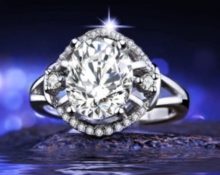According to the famous song, everyone knew the name of the girl’s best friend – a diamond. And it’s hard to argue with this, because a diamond will complement and complete any look. It is appropriate in any life situation, depending on the style of the product. Suitable for people of any age and gender.
Oddly enough, it has one drawback - not everyone can distinguish it from artificial cubic zirconia. Both look expensive, play beautifully with light and fit into all jewelry, from earrings and rings to teeth inlay. And there are unscrupulous manufacturers who pass off cubic zirconia as a natural stone and inflate its price.
Therefore, it is important to learn to distinguish stones without relying on the cost of the product.
How to determine whether a ring is a cubic zirconia or a diamond
The most common decoration with natural stone is a ring. It is appropriate for engagement, birthday and any other occasion. There are both men's and women's diamond rings.

A natural stone ideally has 57 cuts with sharp ends, while cubic zirconia is characterized by rounded cuts and in smaller quantities. But today this method cannot be trusted 100%, because they have learned to cut cubic zirconia in the same way as a diamond.
REFERENCE! Cubic zirconia was invented in the Soviet Union. It was named after the place where it was first synthesized - the Physical Institute of the USSR Academy of Sciences. Abroad it is called zirconite or jevalite.
To accurately determine the authenticity of a material, jewelers use a magnifying glass. The stone is brought close to the eyes in daylight and carefully peered into the faces. A fake has double edges, which is impossible with a genuine stone.
But this method is used by specialists, because an unaccustomed eye may not notice important details.
Hardness
Rub the product with sandpaper - the diamond will not be damaged because it is very hard. Cubic zirconia will be scratched.

You can test the hardness of a diamond with glass. Just draw a line on the glass - the diamond will leave a mark, because it is stronger than glass, but cubic zirconia is not.
IMPORTANT! Today we have learned how to make high-hard cubic zirconia, which can also scratch glass. Therefore, this is not the most reliable way.
Steam
Breathe on the product or expose it to steam; the fake will fog up, but the natural stone will not. If you put the ring in water and touch the stone, it will feel like the stone is made of soap. This will not work with cubic zirconia, because this is typical only for natural stones. This sensation occurs because the diamond absorbs gases in the water.
REFERENCE! Absorption of gas in water is a kind of dissolution of gas in liquid.
Stickiness
Lubricate the stone with oil or other fat and apply it to the glass - the diamond will stick, but the cubic zirconia will not.
Drop oil onto a pebble - on a natural one the drop will remain intact, on an artificial one it will scatter into small particles, and then gather again.
Clearance
Look carefully into the gap - the diamond is transparent and often has small defects. This is a sign of authenticity, because artificial materials are always perfect and do not have a single flaw, as long as they are not scratched, of course.

Temperature
Each stone has its own thermal conductivity, and authenticity is determined based on this property using a special tester. But there's a catch here. The diamond has an analogue with similar thermal conductivity - moissanite. Natural moissanite is so rare in nature that it has been banned from being used for jewelry. But scientists have learned to synthesize its analogue, which is not inferior in appearance and some properties to the natural one.
REFERENCE! Natural moissanite was discovered by a scientist from France, Henri Moissan. He found it in a fragment of a meteorite that he found in the USA. Due to the high cost of producing moissanite, very little of it is made. Therefore, the stone is unique even today.
But in addition to a special device, there is another method related to temperature:
- put your finger on the stone - the diamond remains cold in any situation, and the cubic zirconia will heat up from the heat of your body.
Transparency
If you hold a diamond up to daylight and look at it, you will see a cloudy dot because the stone does not allow sunlight to pass through. But cubic zirconia will be translucent, because it does not create obstacles to the passage of light. For this reason, it is possible to read letters in a book through cubic zirconia, whereas a diamond will not allow this.



 0
0






And I like gems. For some reason, diamonds don’t inspire me, they leave me indifferent. And the point here is not their cost. So my friends are definitely not diamonds.